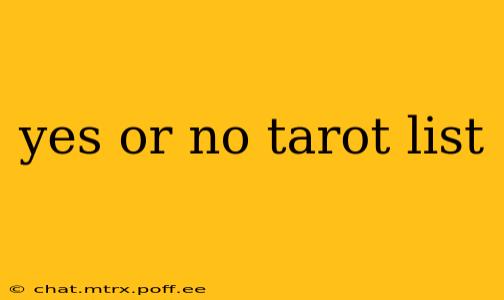Yes or No Tarot List: A Comprehensive Guide to Interpreting Simple Spreads
The tarot, a deck of 78 cards rich in symbolism and history, can offer guidance on a wide range of life questions. While complex spreads delve into nuanced details, a simple "yes or no" reading can provide quick, focused answers. This guide will explore how to use a tarot deck for yes/no questions, offering strategies for interpretation and addressing common concerns.
How to Perform a Yes/No Tarot Reading:
The beauty of a yes/no tarot reading lies in its simplicity. You don't need extensive knowledge of tarot card meanings to get started. Here's a straightforward approach:
-
Ask a Clear Question: Phrase your question as a simple yes or no query. Avoid vague or open-ended questions. The more specific your question, the clearer the answer. For example, instead of "Will I find love?", try "Will I meet someone special at the upcoming conference?".
-
Shuffle and Choose: Shuffle your deck thoroughly, focusing on your question. Then, choose a single card.
-
Interpret the Card: This is where understanding some basic card meanings comes in. However, even without deep tarot knowledge, you can utilize intuitive interpretation. Certain cards tend to lean towards "yes" while others suggest "no" or indicate a more nuanced response.
Interpreting Cards: A Simple Guide
While interpretations can be subjective, here's a general guideline:
-
Generally "Yes" Cards: These cards often represent positive energy, movement, and progress. Examples include: The Sun, The Star, The Lovers (depending on the context), The Emperor, The Empress.
-
Generally "No" Cards: These cards may symbolize obstacles, delays, or the need for reassessment. Examples include: The Tower, The Three of Swords, The Five of Pentacles, Death (often represents significant change, not necessarily negative).
-
Cards Suggesting "Maybe" or "It's Complicated": These cards often indicate uncertainty, the need for further consideration, or the influence of external factors. Examples include: The Moon, The High Priestess, The Hermit, The Wheel of Fortune (representing change and uncertainty), The Judgement.
Addressing Common Questions:
What if I get a card I don't understand?
Don't worry if a card's meaning is unclear. Trust your intuition. What feeling does the card evoke? Does the imagery suggest a positive or negative outcome related to your question? If you’re truly stumped, consider consulting a tarot guidebook.
Can I use the same card multiple times for different questions?
It's generally best to use a fresh card for each question. This ensures you receive a clear and unbiased reading for each inquiry.
Is this method accurate?
The accuracy of a tarot reading depends on many factors, including the clarity of your question, your own intuition, and the energy you bring to the reading. Consider it as a tool for self-reflection and gaining insight, rather than a guaranteed prediction of the future.
What are some other simple tarot spreads for yes/no questions?
While a single card is sufficient, some readers prefer a two-card spread. One card could represent the present situation, and the other the potential outcome. Or one card could show the challenges and the other the opportunities.
Conclusion:
A yes/no tarot list, while simplistic, can be a powerful tool for gaining clarity and direction. Remember to approach your reading with an open mind, trust your intuition, and embrace the insights gained. The key is to focus on the overall feeling and message conveyed by the chosen card, rather than rigidly adhering to strict interpretations. The tarot is a journey of self-discovery; enjoy the process!
